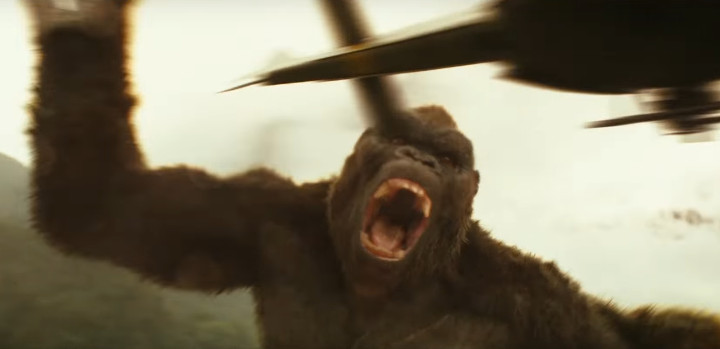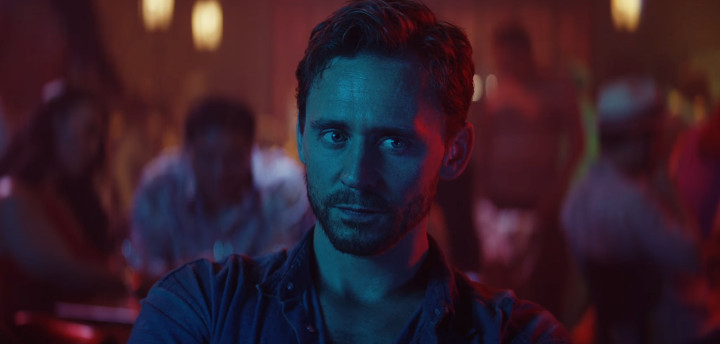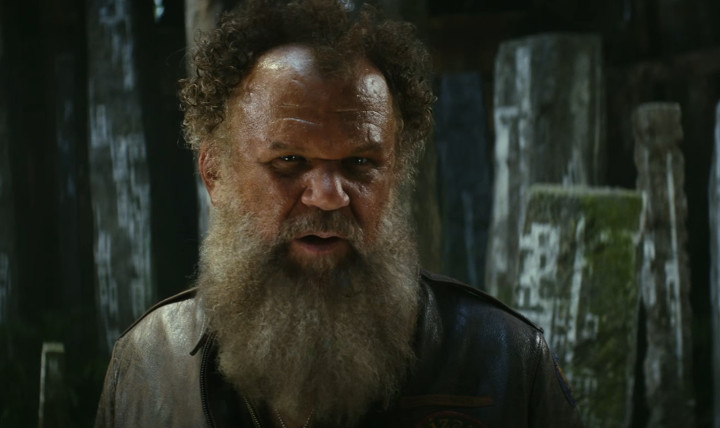
Kong: Skull Island was a movie that should have felt hackneyed, unambitious, and overly familiar. It was at times all of those things, but boy, was it some good ol’ fashioned schlock.
If you’re planning on checking out the film for yourself, be warned — there are spoilers to follow.
Prior to my viewing of the film, I caught wind of an honest-to-goodness after-credits scene. Typically, after-credits scenes hint at an upcoming sequel or expand a cinematic universe. “What more could be told of Kong fighting Vietnam vets in the 70s?” I wondered. I sat in a slowly emptying theater, watching hundreds of visual FX animators’ names scroll past a refreshingly colorful credits backdrop to find out.
The screen faded to black and then… Tom Hiddleston insulted me.

“You’re just gonna sit there? In the dark? You’re enjoying this, right? Is this fun for you?”
When you’re sitting alone in a dark theater on a cold Monday afternoon, these are awfully harsh words to hear.
The scene continues as Tom Hiddleston and Brie Larson shout perturbedly at two-way mirrors in an interrogation room before the film’s scientists show the audience a highlight reel of monster sightings. Godzilla, Mothra, Rodan, and King Ghidorah all apparently share a world with the gargantuan ape and will appear in some form in Godzilla: King of the Monsters, Godzilla vs. Kong, or an unnamed future release in the Monster-verse.
But Kong lost me before this revelation. Hearing the voice of Loki, an actor whose career is now built on shared universes, belittle a paying audience taking part in what has become a movie-going tradition for decades — it kind of hurt. His words bit through what was an otherwise post-monster-slugfest euphoria. I can grasp the tongue-in-cheek nature of the lines, but the scene unwittingly portrays the audience as a faceless, demanding observer, detaining these attractive and personable actors until the plot can come along and drag them back into another harrowing installment of a multi-million dollar franchise. It speaks to a cynicism in the post-credits where once there dwelt heart.

To demonstrate, let’s harken back to one of my favorite after-credits scenes, from the 1985 classic Young Sherlock Holmes. I only ever watched this bizarre and charming film on VHS, and my family must’ve checked it out from the library a dozen times before we inadvertently let the credits roll to the end. We gasped as an unfamiliar, snow-white countryside enveloped our screen, revealing the film’s villain to be a young James Moriarty. We had never known to look for anything of the sort, and the discovery brought new joy to an old favorite.
Take the audacious excitement of the earlier Marvel Cinematic Universe after-credits scenes. Before the massive shared universe was even a twinkle in Kevin Feige’s eye, Iron Man and The Incredible Hulk gave us startling cameos and enigmatic hints of what was to come. With so many of these franchises plotting out their films so far in advance, much of the thrill has left, leaving us with whatever Ben Affleck and Viola Davis’s tete-a-tete after Suicide Squad was.
Remember Gilderoy Lockhart’s confused mug on the front page of the Daily Prophet after Chamber of Secrets? Or when Howard Jarvis sat through the entirety of Airplane in the back of a parked cab? Or when the Avengers slopped up shawarma post-Battle of New York?

After-credits scenes didn’t used to feel so mandatory. Now you can almost hear Tom Hiddleston’s remarks spoken by a sleazy, money-grubbing Hollywood executive hungrily checking off the shared universe box on their “How to Make a Franchise for Dummies” checklist. The magic of the after-credits scene is waning not from over-saturation, but by compulsion, the idea that a movie like Kong Skull Island needed one a post-credits scene in the first place. The appearance of the Monarch organization already ties this flick to Gareth Edwards’ far less vibrant Godzilla from 2014, and audiences will likely have forgotten this scene by the time Godzilla: King of the Monsters rolls around in 2019.
But you know what did work for Kong’s credits?

When the film opens, we see two downed WWII pilots — one American, one Japanese — square off in a fight to the death before Kong appears, colossal and terrifying. When we meet John C. Reilly’s Hank Marlow much later in the film, we discover that he is the 28-years-older version of the opening’s pilot and that he befriended his Japanese adversary, Gunpei. We learn that Marlow left a pregnant wife back home in Chicago when he left for the Pacific, how he yearns to be reunited with a family he no longer knows, and that encountering fellow Americans is as precious as holding a cold beer and a hot dog.
John C. Reilly brings warmth and humanity to a film with rather wooden performances from its leads (Samuel L. Jackson not included). So when the credits treat us to a sequence of dialogue-free shots of Hank Marlow knocking on the door of his old home, holding his tear-stricken wife in his arms, shaking his son’s hand, and holding a cold beer and a hot dog, Kong gives us a heartfelt closure to a truly colorful adventure.
Now if you’ll excuse me, I just discovered Planes, Trains, and Automobiles has an after-credits scene.
